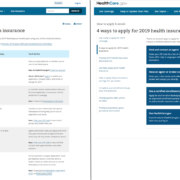
Consumer experience highlights potential risks of relying on agents and brokers, as the Trump administration loosens rules on health plans that do not comply with the Affordable Care Act
Continue readingIn overhaul of HealthCare.gov webpage, information about ways to apply is gone

Links on the ACA enrollment page now direct to third-party sites, including a for-profit assistance system
Continue readingCMS removes PDF used to train assisters in providing healthcare outreach to Latino communities

The training resource, which had still-accurate information, was taken down from the CMS.gov Health Insurance Marketplace website without notice
Continue readingOn content management systems and an unreasonable need to DIY
TL;DR I want to write a new CMS and force people to use Markdown. Should I?
As Ali mentioned in a previous post, we are embarking on an effort to redesign and reorganize SunlightFoundation.com. Part of the reorg involves consolidating our "brands" back under the Sunlight Foundation umbrella so that our content reflects what we do and not our organizational structure. The plan is to merge our existing labs and reporting blogs into technology and reporting channels on our main blog.
With this, though, comes some major technical challenges. One such challenge is having to merge content from a myriad of existing CMSs. We have one blog running on our own django-blogdor application, another running a forked version of django-blogdor (don't ask), and two more blogs running WordPress on the backend but using django-wordpress for the public facing Django-based site. Once the blogs are dumped into an Atom-based format (with custom elements for additional metadata) they can be reimported into the new content management system. What that system will be is a decision that causes me constant angst.
We could just use WordPress like we are now where a private instance is used for authoring and Django pulls from the WP database for presentation on the public site. There are some requirements that would require us to develop WordPress plugins to keep track of additional metadata and make an internal version of django-wordpress that is aware of the plugin tables. To make things even more complicated, there isn't a good way to map Django models to WP tag/taxonomy tables since Django models cannot handle compound keys. This results in quite a bit of database overhead when tags on a large number of posts are accessed. Another option would be to take this a step further and create a generic RESTful API around the WP database that our public site can use. This approach, which would allow us to swap WordPress out for other blog engines at will, is being used by Talking Points Memo.

But if we have to do all of this development just to use WordPress as a backend content store, why use it at all? Why shouldn't we just reinvent the wheel and write our own CMS? The actual management of content isn't hard; django-blogdor can do this just fine and would require only minimal improvement. The hard part, which WordPress does well, is the authoring interface.
Ah, the authoring interface. That brings us to the biggest source of contention. Whenever I discuss this project with the rest of the organization, I'm always told that a WYSIWYG editor is crucial. While I understand the need to insert media and add headings, I'm less sympathetic to other forms of visual styling such as the changing of font colors. I find myself increasingly convinced that content creators should be using Markdown to author their posts in a tool that has WYSIWYG-like helpers for inserting chunks of markup or HTML. Not only does this produce cleaner HTML that is more fault tolerant to future changes, but it creates a clear separation between the creation of content and it's visual display. Plus Markdown is just easy; you can pick it up in a few minutes. More complicated visual needs can and should be handled by our design team or built into the CMS. I want to free our authors from having to worry about presentation and focus on what they do best, writing good content. How considerate of me!
So I come to you, dear reader, for advice on what we should do.
- Am I being unreasonable here with my urge to write yet-another-CMS? Feel free to tell me to shut up, suck it up, and make it work with WordPress.
- Is it snobbish and elitist to expect content creators to use either Markdown or learn HTML rather than use a WYSIWYG editor?
- Any better suggestions?
Can we rate heart surgeries like blenders?
The Consumers Union, publisher of Consumer Reports, released a set of ratings yesterday for something rather more important than appliances: heart bypass surgery. Using data submitted to the Society of Thoracic Surgeons (STS), the Consumers Union has graded various heart surgery groups using a three-star scale, similar to the way it rates radios, cameras and washing machines. It's a set of valuable public data that could serve as a model for expanding the Department of Health and Human Services' open government sites like Data.medicare.gov and the Community Health Data Initiative.
The heart surgery ratings are based on ...
Continue readingLack of disclosure protects bad nursing home firms
The pattern of understaffing at Skilled Healthcare Group's 22 California nursing homes could have raised red flags for patients and their families, but ownership information is currently difficult to obtain. The company has been ordered to pay $670 million for violating California state staffing minimums. A portion of the fee, the result of a class action lawsuit, is intended to refund patients for the quality of care they received.
Nursing Home Compare, the Center for Medicare and Medicaid (CMS) site that allows the public to evaluate nursing home performance, does not yet identify the names of nursing home owners ...
OGD: A state-by-state look at Medicare payments
Over the last few years, hospitals in a few states have consistently received more money than others from Medicare in so-called "outlier payments" for inpatient services. These additional payments are handed out when a hospital takes on an unusually expensive case.
This takeaway comes from a quick review of the Center for Medicare and Medicaid Services (CMS)' "Dashboard," a new online repository of spending data.
While the Dashboard is still in its beta version, and currently only has inpatient data (no home health or nursing home information, for example), a few points ... Continue reading
OGD: Future Medicare data looks promising
The Centers for Medicare and Medicaid Services appear to be on to something with their promised new datasets. It's a leap for an agency whose previous offerings were a confusing mishmash of poorly-labeled files. If they continue to add granularity as they roll out more features, journalists could have a useful and innovative set of tools on their hands.
The “Dashboard” CMS intends to create, a demo of which is currently online, looks at Medicare spending on services. It's a good tool for quickly grasping the big picture; you can view data as a bubble chart, for example ...
Content Management Systems just don’t work.
Somebody asked me the other day what I thought of Recovery.gov using Drupal and it got me thinking about content management systems. In my consulting days, I watched companies and political campaigns and non-profits sometimes spend hundreds of thousands of dollars annually trying to make their content management system do what they wanted it to do for their online campaigns. As an honest developer and honest consultant, this made me apoplectic-- I knew that at the end of the day, technically what they wanted was fairly easy to build. But they had to pay hundreds of dollars an hour to get a "Drupal Specialist" at an outside consultancy to set up simple pages because they could not figure out how to get the stuff to work right.
I think if your budget for your website is $40,000/yr or more, you shouldn't be worrying about Content Management Systems at all. You should be worrying about hiring. I'll explain why after the jump.
Continue reading

